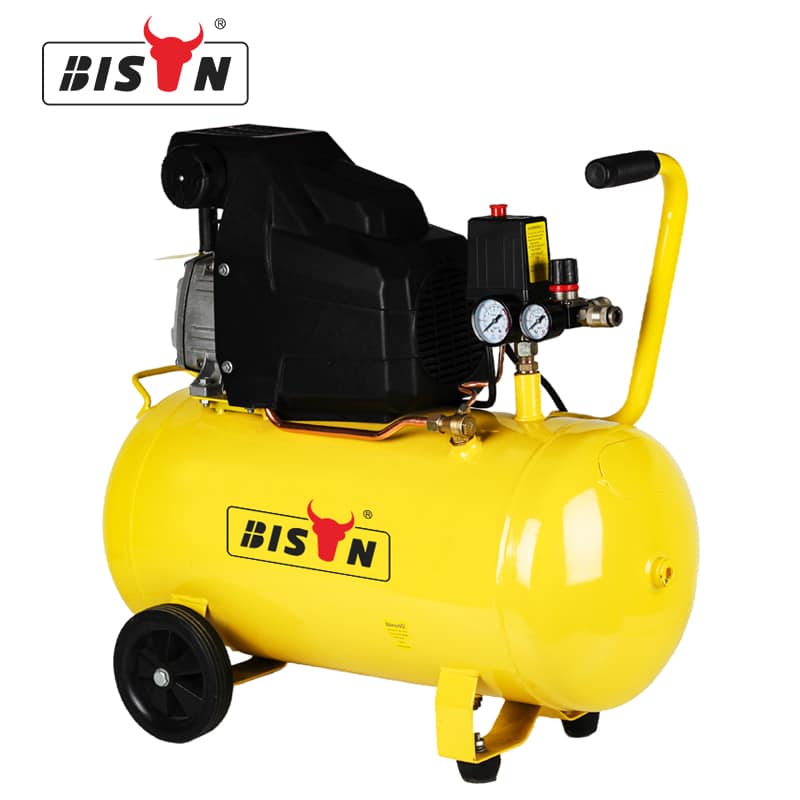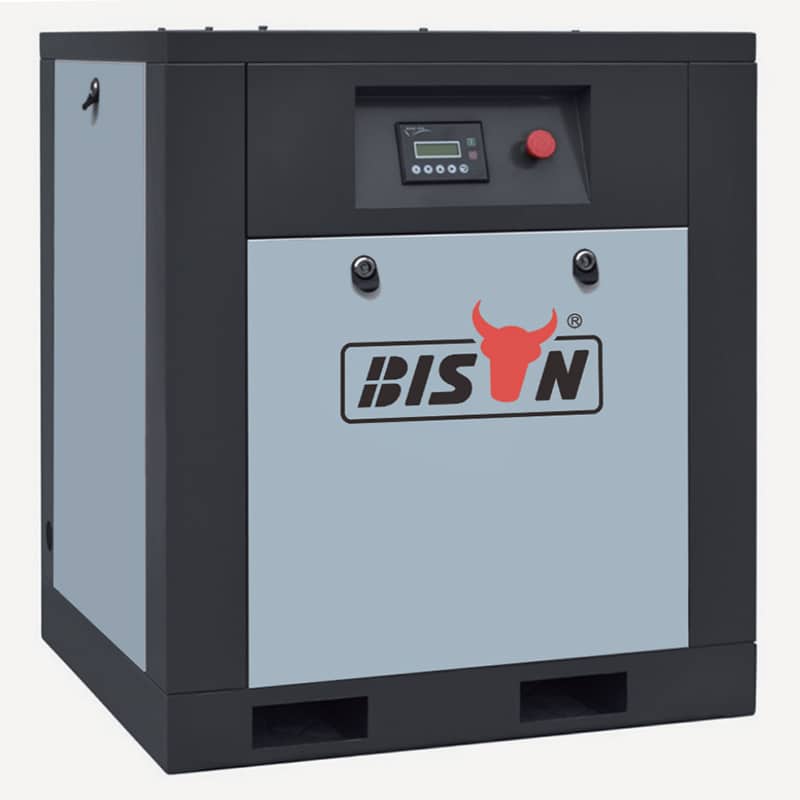air compressor blog
how do air compressors work
- Mar 21, 2023
Air compressors are essential to the operations of factories and workshops worldwide. But they haven’t always been. In the historical context of the machine age, the air compressor is a relatively new invention.
Before the advent of air compressors, many tools were powered by complex systems with wheels, belts, and other large components. Such machines are heavy and costly and are often out of reach for many small operations. Nowadays, air compressors come in various sizes and designs, and you may find them anywhere from enormous workplaces to your neighbor’s garage.
In this article, we’ll cover how an air compressor works, covering everything from its basic purpose to how different compressors handle air.
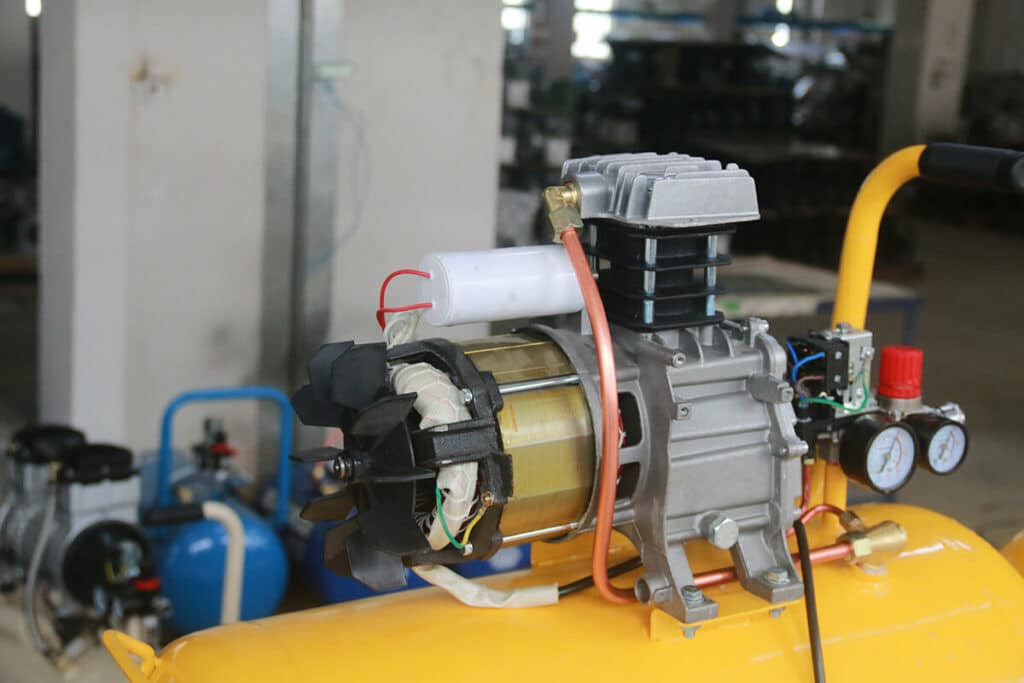
how does an air compressor work?
An air compressor functions by harnessing the power of the atmosphere, pressurizing air to create potential energy that can be stored for future use. Imagine a balloon that’s been inflated – the built-up pressure is released when the balloon is let go, transforming the potential energy into kinetic energy. This energy conversion can then be utilized to drive various pneumatic tools.
The operational principles of industrial air compressors are akin to those of combustion engines. Typically, the functioning of an air compressor involves a pump cylinder, piston, and crankshaft, all working in tandem to transfer energy for a myriad of tasks. These fundamental elements enable the compressor to provide air for inflating items such as tires or pool toys, as well as powering tools like drills, nail guns, grinders, sanders, and spray guns.
Air compressors are integral to a plethora of tools and machines that enhance our daily lives, from impact wrenches to air conditioning units. Their role in providing comfort, shelter, automation, and efficiency cannot be overstated. Despite their powerful capabilities, air compressors are compact and lightweight compared to other centralized power sources. They are also durable, require less upkeep, and offer greater mobility than traditional machinery, making them a preferred choice in many industries.
Types of Positive displacement air compressors
Since positive displacement is the more common type of air compression method, many types of positive displacement air compressors exist. However, everyone works differently. Here are a few types of the various positive displacement air compressor types:
rotary screw air compressor
Rotary screw compressors are typical for industrial use and come in sizes suitable for many applications. Inside the motor of these compressors are two screws that rotate continuously in opposite directions. The movement of the screw creates a vacuum that draws in air. Air is trapped between the threads of the screw and compressed when force is applied between them. Finally, it goes through the output or into the safe tank. Most rotary screw compressors are industrial size and lubricated with oil, but oil-free compressor designs are also available.
Here’s a more technical introduction to how oil-injected rotary screw compressors work:
- Atmospheric air enters the compressor at the intake valve.
- The regulator valve receives air through the pressure control line, a process that sets the air pressure in the system.
- The air then enters the compressor, where it combines with the oil to form a mist.
- When the two inner screws are rotated in opposite directions, the air moves along their lengths.
- The screw motion creates a vacuum that traps and compresses air in the space between the screws.
- While mixing with the oil as a mist, pressurized air is pushed through the output and into the primary oil separator tank.
- The centrifugal force within the tank causes most of the oil molecules to form droplets and collect at the bottom as reusable oil.
- The air then enters the secondary separation filter, which removes more oil and further purifies the air.
- Oil-free air leaves the system and is stored in a tank or immediately used in connected air tools or machinery.
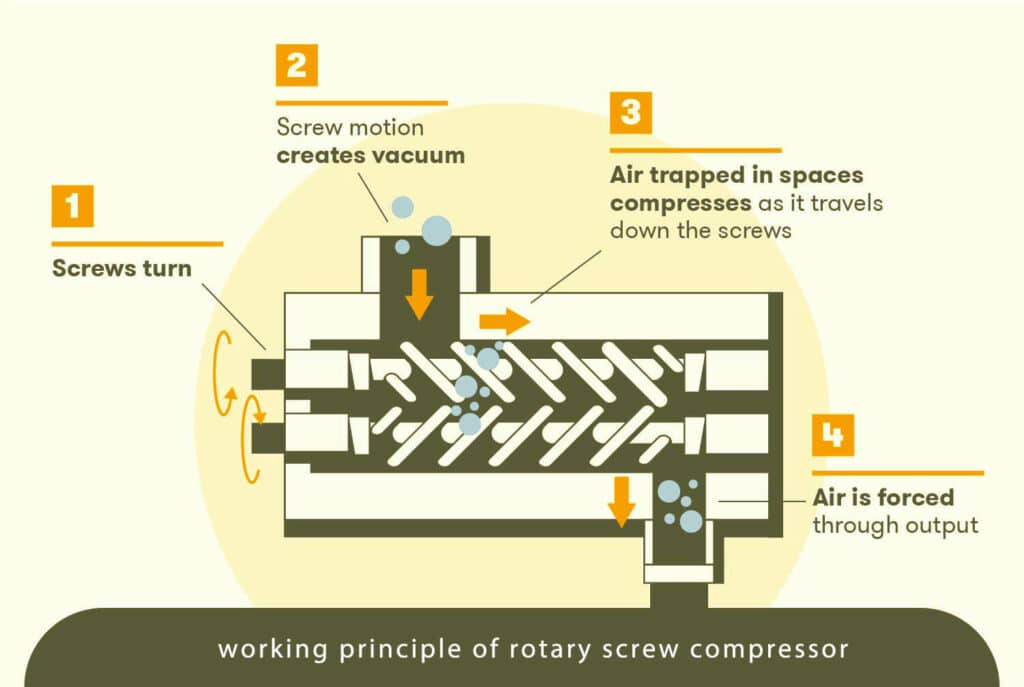
Reciprocating/Piston Air Compressor
The most common kind of air compressors are reciprocating ones. In a reciprocating air compressor, the rotation of the rotor forces the piston to move up and down. As the piston descends, separate air is drawn into the chamber. Then, as the piston rises back up, the air is compressed and forced back outward. Some compressors that use only one piston are called single-stage compressors. Other compressors, called two-stage compressors, use two pistons and are able to pressurize more air. The way air compressors work can vary by design. There are two different compression cycles that can be used in piston-based air compressors: signle stage air compressor vs two-stage air compressor
Single stage air compressor
The piston compresses the air once. The stroke is one complete revolution of the crankshaft drive piston. Many of these compressors are perfect for private projects because of their straightforward single-stage construction.
The following are the technical steps for the operation of a single-stage air compressor:
- The rotation of the rotor forces the individual pistons to move up and down.
- As the piston moves down, atmospheric air is drawn into the compression chamber through an open valve.
- The air is compressed as it is pushed into the output chamber when the piston moves up.
- The compressed air is then pushed via the compressor’s output.

Two-stage air compressor
The first piston compresses the air, then moves it to the smaller cylinder, and the other piston compresses the air further. The compressor can produce larger pressures thanks to this design, which makes it perfect for factories and workshops.
Here’s how a two-stage air compressor works:
- The rotor spins to control both pistons simultaneously, forcing each piston to move up and down in opposite directions.
- The larger piston draws air into the first compression chamber and pushes it out to the intercooler.
- Intercoolers use a continuous flow of water to cool the air.
- The smaller piston compresses a lot of air into a compact space, pressurizing it further.
- A small piston then pushes the compressed air through the outlet.

Axial compressors

An axial compressor is a compressor that uses a series of rotating and stationary airfoils to compress a fluid. The working principle of the axial flow compressor is that the working fluid enters the compressor through the inlet, and then flows in a direction parallel to the axis of the rotor. As the fluid passes through the moving blades, kinetic energy is added to the fluid and its pressure increases, but at the expense of the fluid’s relative velocity being reduced. The compressor consists of rows of airfoils located between a central drum and a fixed casing, with each row attached to the drum or casing in an alternating fashion. The compressor is driven by a shaft, which is held in place by bearings inside the housing. The pressure of the fluid can be further increased by providing diffuser channels between the vanes.
Centrifugal compressors
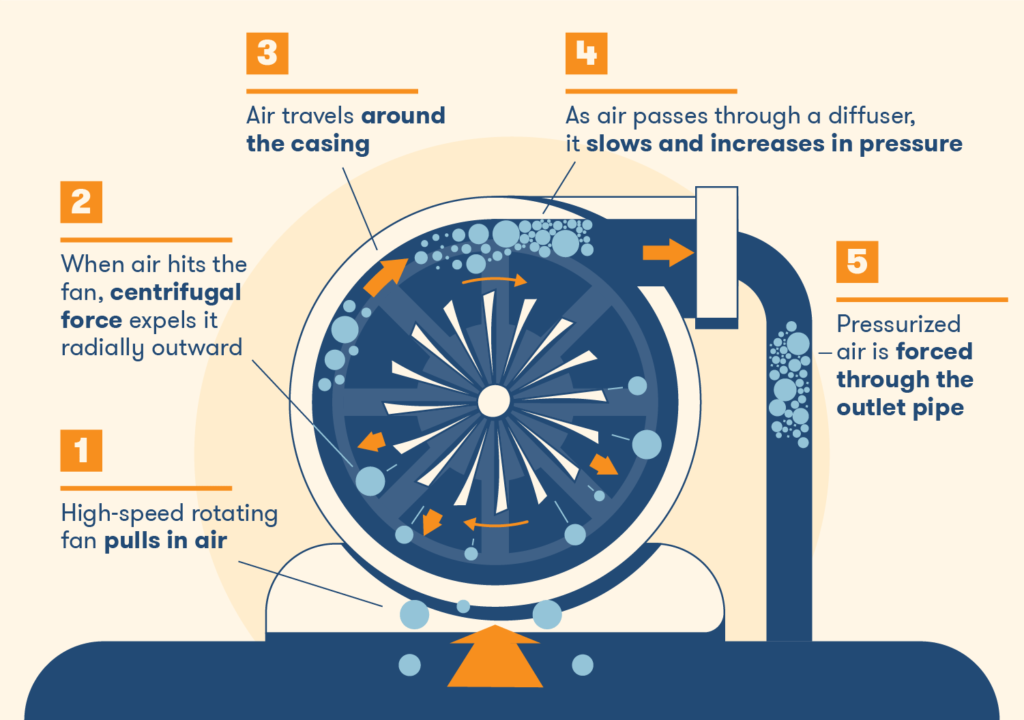
Centrifugal compressors work by using a rotating impeller to add kinetic energy to air particles, then slow them down suddenly, increasing the pressure. The impeller is housed in a housing or casing and has an inlet and an outlet. When air enters the impeller, it is sucked into the center of the impeller by the radial blades, and then pushed towards the center by centrifugal force as the impeller continues to rotate. Radial movement of gas or air increases pressure and generates kinetic energy. The compressed air then exits the impeller and passes through a diffuser, which converts high-velocity, low-pressure air into high-pressure, low-velocity air. The compressed air then leaves the compressor through the collector.
What air compressor do I need?
As an air compressor manufacturer, understanding our customers’ needs is crucial. The size of the air compressor you require is largely determined by the type of pneumatic tools they utilize and the frequency of their usage.
Consider these essential factors when determining the appropriate air compressor size:
- CFM (Cubic Feet per Minute): This denotes the volume of air that the compressor can deliver. A higher CFM allows for simultaneous operation of more air tools.
- PSI (Pounds per Square Inch): This metric indicates the air pressure that the compressor can generate. Higher PSI values translate into more powerful air tools.
- Tank Size: The capacity of the tank dictates the duration the compressor can operate before recharging is necessary. Opting for a larger tank reduces downtime.
- Portability: If the compressor needs to be moved frequently, a model designed for portability would be advantageous.
Here are some general recommendations for selecting an air compressor size based on task intensity:
- Light-duty tasks: A compressor with 1-5 CFM and a 2-5 gallon tank should suffice.
- Medium-duty tasks: A compressor offering 5-10 CFM with a 5-10 gallon tank is recommended.
- Heavy-duty tasks: A compressor providing 10-15 CFM and a tank size of 10-20 gallons should be adequate.
These are broad guidelines and may not apply to every situation. It’s advisable to consult with an air compressor professional or conduct thorough online research to identify the most suitable air compressor size for your specific needs. Remember, choosing the right air compressor not only enhances productivity but also extends the lifespan of your air tools.
BISON
BISON offers a wide range of high-quality air compressors, including screw, reciprocating/piston, and oil-free. Contact us today if you need an air compressor for any of your needs.
If you have any enquiries about the BISON air compressor, we would love to hear from you.

